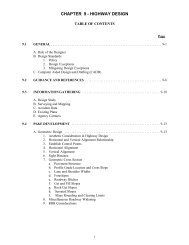Baltimore-Washington Parkway Widening Feasibility Study
Baltimore-Washington Parkway Widening Feasibility Study
Baltimore-Washington Parkway Widening Feasibility Study
- No tags were found...
You also want an ePaper? Increase the reach of your titles
YUMPU automatically turns print PDFs into web optimized ePapers that Google loves.
<strong>Baltimore</strong>-<strong>Washington</strong> <strong>Parkway</strong> <strong>Widening</strong> <strong>Feasibility</strong> <strong>Study</strong>Traffic and Transportation Impacts5.3.42040Full-BuildScenarioThe Full-Build scenario assumes additionalwidening of the B-W <strong>Parkway</strong>, relative to the2040 No-Build scenario, to provide threegeneral-use travel lanes in each directionover the entire length of the <strong>Parkway</strong> fromMD 450 to MD 175. With the existing threelanesection south of MD 450 and thecompletion of widening north of MD 175 byMaryland SHA provided in the No-Buildscenario, the Full-Build scenario providesthree general-use travel lanes in eachdirection through the full length of the studyarea from John Hanson Highway (U.S. Route50) at the District of Columbia boundary tothe <strong>Baltimore</strong> Beltway.Figure 5.4. Full Build Scenario Lane Configuration5.4AnalysisResultsThis study identified the effect of the various future year widening options on traffic volumes and levelof-serviceon the mainline segments of the B-W <strong>Parkway</strong>.5.4.1TrafficVolumesThe MWCOG travel demand models incorporate anticipated regional growth in population,employment, and related activities across both the <strong>Baltimore</strong>, Maryland, and <strong>Washington</strong>, DC,metropolitan areas as shown in the table below.Projected Growth in the <strong>Baltimore</strong>-<strong>Washington</strong>, DC Metropolitan Region2005 2040 GrowthPopulation 6,262,508 8,613,982 38%Employment 3,700,075 5,457,004 47%Sources: Metropolitan <strong>Washington</strong> Council of Governments and the <strong>Baltimore</strong> Metropolitan CouncilReflective of these anticipated changes in population and employment across the <strong>Baltimore</strong> and<strong>Washington</strong>, DC, metropolitan areas, total travel demand is similarly expected to increase significantlyover the next several decades in the corridor between the <strong>Baltimore</strong> and <strong>Washington</strong> urban cores. The47 November 2012
















